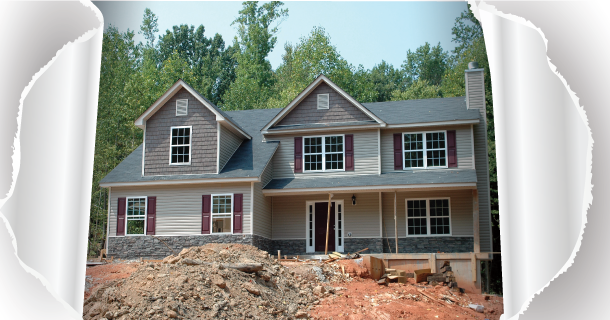
– An Interesting Look at Housing Starts
Depending on where you are in the country, it may or may not be unusual for you to work with a buyer who finds the ideal lot in the ideal neighborhood – but it just happens to have an old and outdated home on the property. Although the cost to build new when one has to demolish first is usually greater than building on a blank slate, the buyer proceeds and builds the home they have been dreaming of.
According to the National Association of Homebuilders, in 2015, almost 8% of all single family home starts were attributed to homes that were built to replace demolished and torn down homes (called tear-down starts). This is interestingly a high number, especially considering it doesn’t take into account infill lots or infill development. These are vacant pieces of land without any previous structures. It may be the last lot in a subdivision that a builder no longer wants to build on or a builder that may have sold the rest of the homes in the development and has decided he/she wants to move on and sell the last lot(s).
There are a number of reasons why a buyer or builder decides to go the tear-down route:
- The home may be structurally unsound due to age.
- The condition of the home is such that it is more financially feasible to rebuild than salvage what they have.
- There are other geotechnical issues that must be addressed on the lot so that a rebuild is necessary (such as in areas that are prone to landslides or flooding).
- There may be growth restrictions in place and land available to develop is scarce.
- The buyer loves the lot, loves the neighborhood, and no infill lots are available.
In the United States in 2015 there were 55,200 new single family homes built to replace demolished or torn down homes. These are broken down into the four principal Census regions as follows:
- West: 10,600 – about 19% of the US total
- Midwest: 8,100 – about 15% of the US total
- Northeast: 8,000 – about 14% of the US total
- South: 28,600 – about 52% of the US total
The higher numbers in the West and the South clearly represents the high demand these areas have for housing turnover. The reason these numbers are so important to track is that they measure the strong demand for single family housing in the West and South.
This study also measures the age of these homes when they are being demolished. The East has the oldest “home stock”, yet the number of these homes demolished is much less than the areas with newer housing. This indicates a greater tolerance for older historic homes while the areas with high turnover value new construction with modern innovations. Historically the East has been more tolerant of older homes. However, because of the lack of land available, there have been proportionately more tear down starts in the East than in the West and the South.
In the fast-paced market in the West, we are finding that many of the tear-down lots (or homes slated to be demoed) are being scooped up by both builders and buyers. These lots are selling for record high prices with either future homeowners or builders building new construction once the existing home is torn down.
As an agent, don’t overlook the possibilities here. A home being sold as-is or is in poor condition in an otherwise high-demand area may be a great fit for a buyer if they want to build new. You may also be on the lookout for these types of opportunities for builders who are looking for just the right lot, regardless of whether there is a home on it. Keep track of all lots in your area, infill or potential tear-down, as they represent a great opportunity for buyers and builders.



 Posted in
Posted in  Tags:
Tags: 

Hi Denise,
I’m afraid I cannot atend this next session of april 26th, 27th.
I will definitely attend one. Please let me know when the next one is.
Thank you!
Linda